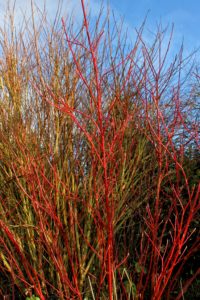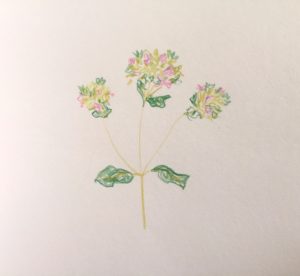This week I have been getting entirely too close to nature, or rather, it has been entering my personal space to different degrees of acceptance from me. But before all that, I have just trodden on a slug – with bare feet! That would be me with the bare feet, of course, not the slug although I guess their one foot is always bare. Anyway, that is how my week ended with regard to wildlife interaction. Squishy.
Earlier in the week I was undertaking the all-too-regular event of trying to get one, the other or both of the cats in for the evening. We keep them in overnight these days which is much better all round: better for us having less vets bills to pay from all the night time scrapping, better for the cats as they have less injuries from all the night time scrapping and better for all the other wildlife as there is less night time killing.
On this night, small cat had evaded our early calls and had taken himself off on a long hike. Either that or he was deploying the tactic big cat uses which is to sit a mere few feet away, hidden and absolutely ignoring our calling and cat treat rattling. But it was a warm night and had become that wonderful time when all the crepuscular creatures head out for foraging, courting and the ever popular night time scrapping. As I stood calling to the small beast I was given a close fly-by by a bat. We get at least one on most nights at this time of year and its lovely to see them lapping the garden. I think I must have been in its flight path though, and I’m sure I could feel it touch lightly as it flew by. I love bats, so this was not a problem.
The next morning, I was sitting outside with a hot water and lemon for a bit of fresh air before starting work for the day. Tucked away with jasmine and honeysuckle behind me, buddleia and a eucalyptus to the left and a plum tree to the right I was nestled neatly among flora. Which is perhaps why a beetle was unable to navigate around me in time and came and gave me a bumbling headbutt before making its awkward flight away. This encounter was fine also. In the same place and only a few moments later a female blackbird skimmed my head having taken off from the fence behind the jasmine. I think she was more startled than I was. (I could not help but think of Carl Bovis, a nature photographer I follow on Twitter who posts amazing pictures of birds in flight with wings and legs tucked in and looking as if they had been pointedly thrown at him by his enemies.) But, a low-flying bird is also quite alright with me.
What was not alright was my next encounter of the week. After a spot of gardening I put my jogging bottoms back on and was having a nice chat with MOTH in the kitchen when all of a sudden I felt a rather painful stab on my bottom (left cheek, if you needed to know). Discarding the joggers to investigate it became clear that there was a wasp in there and the little git 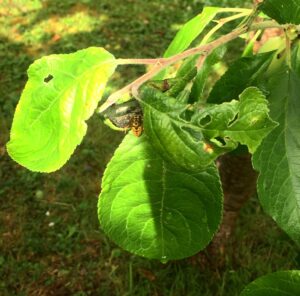 had just stung me. This was not alright. I was not best pleased in the least. MOTH was very good and managed to stop from outright laughing for some time, including when I lay down and asked him to put an apple cider vinegar soaked cotton pad on the, ahem, area. (By the way, this absolutely works for wasp stings to bring down the redness and itching.) Three days on and I can still feel it, but its ok, you can all laugh, even I find it funny – until I sit down.
had just stung me. This was not alright. I was not best pleased in the least. MOTH was very good and managed to stop from outright laughing for some time, including when I lay down and asked him to put an apple cider vinegar soaked cotton pad on the, ahem, area. (By the way, this absolutely works for wasp stings to bring down the redness and itching.) Three days on and I can still feel it, but its ok, you can all laugh, even I find it funny – until I sit down.
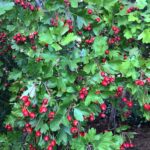 berries and green leaves are draping from the hawthorn trees. Towering
berries and green leaves are draping from the hawthorn trees. Towering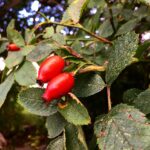 birds love them so. I have made rosehip tea in the past, collecting, cutting, scraping out the insides and drying the hips and it was tasty – but, a lot of not very pleasant work. The inside of a rosehip is filled with prickly, sticky hairs and they all have to be removed or will be an irritant when drinking. It takes a long time to prepare so many fiddly little hips and I know from experience that I don’t really have the patience.
birds love them so. I have made rosehip tea in the past, collecting, cutting, scraping out the insides and drying the hips and it was tasty – but, a lot of not very pleasant work. The inside of a rosehip is filled with prickly, sticky hairs and they all have to be removed or will be an irritant when drinking. It takes a long time to prepare so many fiddly little hips and I know from experience that I don’t really have the patience.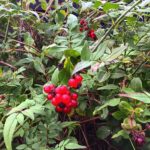 shiny red berries punctuate the long meandering tendrils. It doesn’t seem to matter how much or when I cut this particular honeysuckle back, it soon
shiny red berries punctuate the long meandering tendrils. It doesn’t seem to matter how much or when I cut this particular honeysuckle back, it soon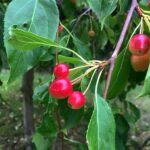
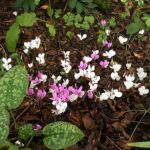 tubers. Cyclamen have their seed heads on tight coils which when ripe project the seed head and seeds onto the ground – the sticky seeds are then sometimes moved about by ants. Just imagine if you could capture the pinging and flinging of seeds by the release of tensed coils on film – I can’t help but visualise it in some sort of Acme cartoon cannon style with some dramatic full-orchestra music going on behind the whizzing and whirring.
tubers. Cyclamen have their seed heads on tight coils which when ripe project the seed head and seeds onto the ground – the sticky seeds are then sometimes moved about by ants. Just imagine if you could capture the pinging and flinging of seeds by the release of tensed coils on film – I can’t help but visualise it in some sort of Acme cartoon cannon style with some dramatic full-orchestra music going on behind the whizzing and whirring.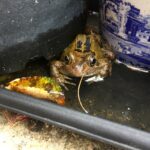 spotted a frog making use of the plant pot tray on her patio. It seemed quite happy and we think perhaps waiting for some of the dropped insect-based bird food from the feeders nearby. And we have a new resident, Gary. Gary is a snail who was doing the sterling job of keeping my niece’s fish tank clean. Alas, the fish are no more, which is timely actually,
spotted a frog making use of the plant pot tray on her patio. It seemed quite happy and we think perhaps waiting for some of the dropped insect-based bird food from the feeders nearby. And we have a new resident, Gary. Gary is a snail who was doing the sterling job of keeping my niece’s fish tank clean. Alas, the fish are no more, which is timely actually, 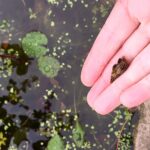 as niece is just about to head off to university. Needless to say, my sister was not about to keep a tank going in her daughter’s absence for just one snail, and so Gary was ferried over to our pond via a small tub with holes in and a fruit basket in the footwell of my car.
as niece is just about to head off to university. Needless to say, my sister was not about to keep a tank going in her daughter’s absence for just one snail, and so Gary was ferried over to our pond via a small tub with holes in and a fruit basket in the footwell of my car.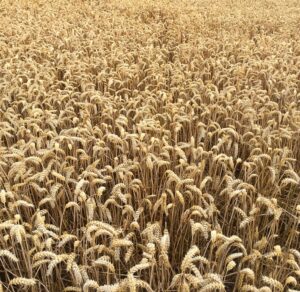 harvested. (This is the time of ridiculously bad hayfever for me and I will now spend the next few months breathing as if I had just run a marathon while playing the tuba). What is it that we normally do which we have not been doing that has allowed a boost in such nature as butterflies? Or, is it that we are just noticing them more because of our changed circumstances? I offer these questions with no answers, by the way, I am merely musing. If it is the former then it makes me feel quite sad because that would show the direct negative impact we humans have on the natural world – I can’t help but have the sneaky suspicion that this is probably true.
harvested. (This is the time of ridiculously bad hayfever for me and I will now spend the next few months breathing as if I had just run a marathon while playing the tuba). What is it that we normally do which we have not been doing that has allowed a boost in such nature as butterflies? Or, is it that we are just noticing them more because of our changed circumstances? I offer these questions with no answers, by the way, I am merely musing. If it is the former then it makes me feel quite sad because that would show the direct negative impact we humans have on the natural world – I can’t help but have the sneaky suspicion that this is probably true.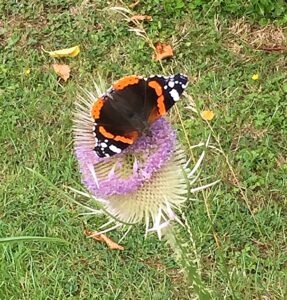
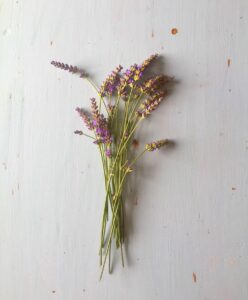
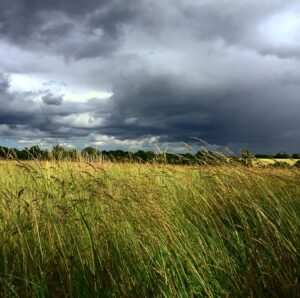
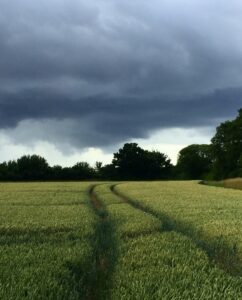 We were promised thunderstorms this week; they did not come – which I was annoyed about. We have had some rain, intermittent sun and
We were promised thunderstorms this week; they did not come – which I was annoyed about. We have had some rain, intermittent sun and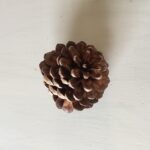 As I picked it up to bring home I realised I experienced the same feeling as I have done in the past when buying a new item of clothing or the such. I read a book recently which talked about how we get used to new things so quickly that they lose their ‘spark’ in very little time which is what compels us to then buy again and again and again. It’s why some very rich people have multiple cars of huge value and still never feel satisfied. They are merely looking for the next hit of new. That being the case, perhaps a pine cone really can have the same excitement-producing reception in the brain that a new pair of boots can.
As I picked it up to bring home I realised I experienced the same feeling as I have done in the past when buying a new item of clothing or the such. I read a book recently which talked about how we get used to new things so quickly that they lose their ‘spark’ in very little time which is what compels us to then buy again and again and again. It’s why some very rich people have multiple cars of huge value and still never feel satisfied. They are merely looking for the next hit of new. That being the case, perhaps a pine cone really can have the same excitement-producing reception in the brain that a new pair of boots can.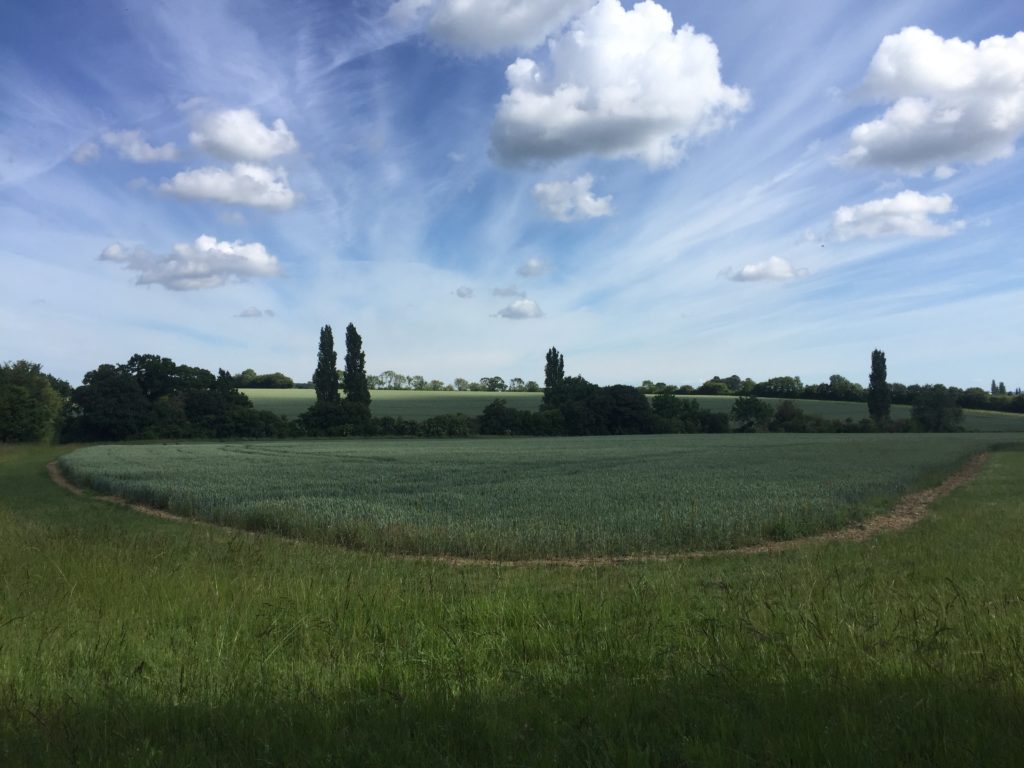
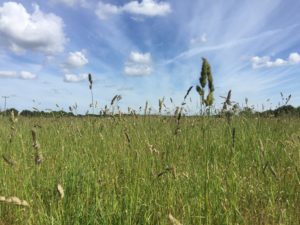 and the beautiful feathery fronds jigged in the breeze with their soft green and purple hues. Beautiful. But, as with as many places there is talk of it being built on which saddens me greatly. I can see brambles beginning to flower in the hedgerows, bringing promises of delicious fruits to come. I will be out picking and eating later in the year.
and the beautiful feathery fronds jigged in the breeze with their soft green and purple hues. Beautiful. But, as with as many places there is talk of it being built on which saddens me greatly. I can see brambles beginning to flower in the hedgerows, bringing promises of delicious fruits to come. I will be out picking and eating later in the year.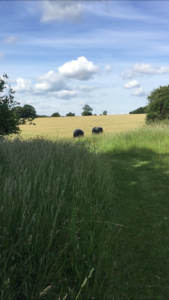 Against all the blue, green and yellow of this early summer day, large shining black plastic greeted me next – the covering for bales of straw. My best friend and I have long loved the sight of bales in fields, particularly as we feel they always seem as if they are grazing. Many a time we have sent each other pictures of such with the caption: grazing bales. I may have tweeted a video at her this time.
Against all the blue, green and yellow of this early summer day, large shining black plastic greeted me next – the covering for bales of straw. My best friend and I have long loved the sight of bales in fields, particularly as we feel they always seem as if they are grazing. Many a time we have sent each other pictures of such with the caption: grazing bales. I may have tweeted a video at her this time.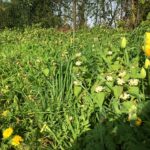 Now that the bulk of flowering is over I have begun to reduce the area by at least half – and found a lovely surprise under it all – a patch of wild garlic which I had no idea was there. Next to the fenced grass pile (which has been phenomenal at giving us mulch at this time when garden centres have been closed) there peered up at me some rather light-deprived wild garlic; rather sorry leaves but lovely delicate white flowers. I am hoping it will recover now that it is not weighed down by comfrey and I might try transplanting some to a place a little easier to get to and keep clear.
Now that the bulk of flowering is over I have begun to reduce the area by at least half – and found a lovely surprise under it all – a patch of wild garlic which I had no idea was there. Next to the fenced grass pile (which has been phenomenal at giving us mulch at this time when garden centres have been closed) there peered up at me some rather light-deprived wild garlic; rather sorry leaves but lovely delicate white flowers. I am hoping it will recover now that it is not weighed down by comfrey and I might try transplanting some to a place a little easier to get to and keep clear.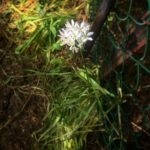
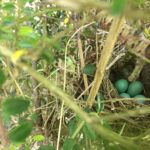 Naturally, I immediately backed off and I am happy to report that I have seen an adult on the nest since, so I am no longer worried about having disturbed it.
Naturally, I immediately backed off and I am happy to report that I have seen an adult on the nest since, so I am no longer worried about having disturbed it.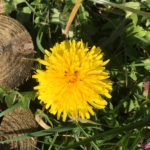

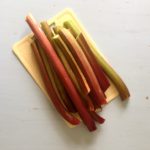 triumphant red arms, defiantly waving enormous leaves at me. And so, as I write this, I have a huge amount of rhubarb chutney simmering away as well as three crumbles ready for the freezer. It is the spider plant of the garden – un-killable!
triumphant red arms, defiantly waving enormous leaves at me. And so, as I write this, I have a huge amount of rhubarb chutney simmering away as well as three crumbles ready for the freezer. It is the spider plant of the garden – un-killable!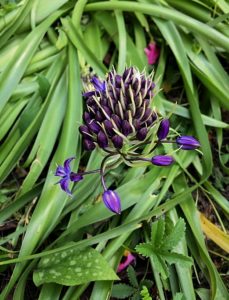 The best thing though, was that they told me that they called them angry panthers, and to this day, that is what I call them too. I know roughly where it is located but the ground covering mat of ajuga, pulmonaria and creeping cinquefoil, has hindered any precise pinpointing – hence the search. So far, the angry panther remains elusive, but I live in hope.
The best thing though, was that they told me that they called them angry panthers, and to this day, that is what I call them too. I know roughly where it is located but the ground covering mat of ajuga, pulmonaria and creeping cinquefoil, has hindered any precise pinpointing – hence the search. So far, the angry panther remains elusive, but I live in hope.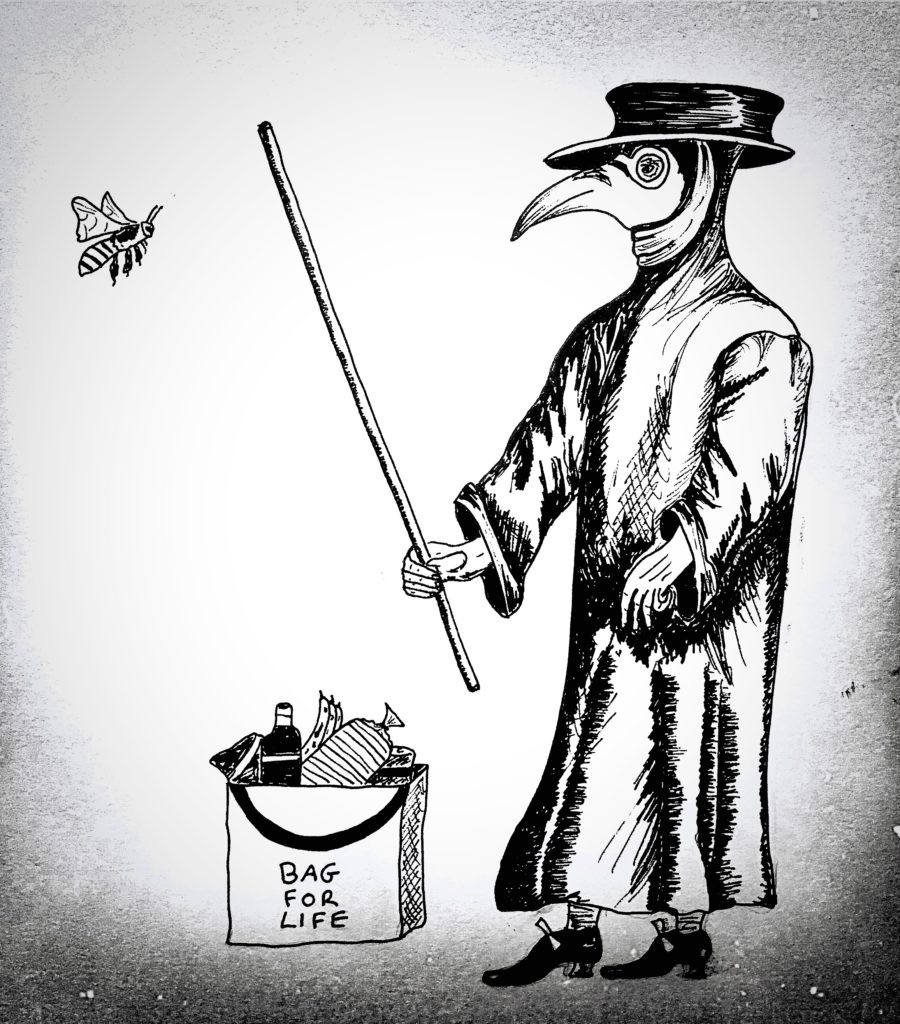
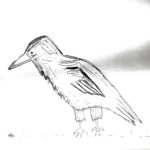 This was in fact what started the plague doctor discussion as I have always been reminded of such by rooks, because of their lighter coloured beaks. They remind me of the masks worn by the doctors treating sick people during the bubonic plague. These masks included a long hollow beak stuffed with highly scented herbs with the thought that this would purify the air. The rest of their costume was often made up of a long heavy coat and gloves and a stick to keep the sick at bay. There was mention that many or all of these things could be useful when doing the weekly shop at the moment.
This was in fact what started the plague doctor discussion as I have always been reminded of such by rooks, because of their lighter coloured beaks. They remind me of the masks worn by the doctors treating sick people during the bubonic plague. These masks included a long hollow beak stuffed with highly scented herbs with the thought that this would purify the air. The rest of their costume was often made up of a long heavy coat and gloves and a stick to keep the sick at bay. There was mention that many or all of these things could be useful when doing the weekly shop at the moment.